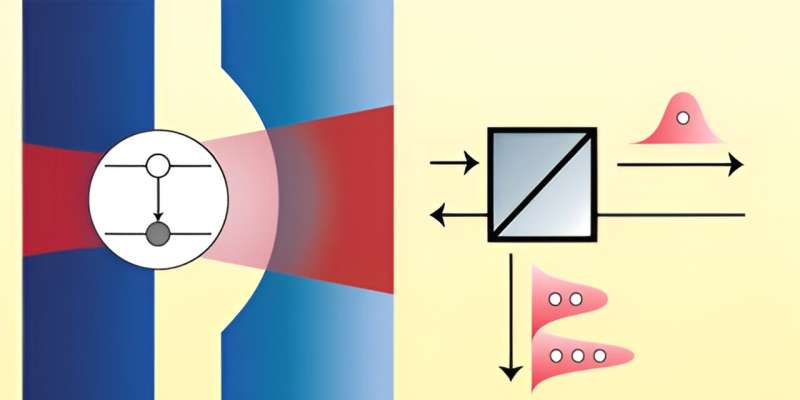
September 2, 2024 by David Appell , Phys.org
Collected at: https://phys.org/news/2024-09-device-photon-states-quantum-optical.html
To build light-based quantum technologies, scientists and engineers need the ability to generate and manipulate photons as individuals or a few at a time. To build such quantum photonic logic gates that might be used in an optical quantum computer requires a special medium which allows strong and controlled interactions of just a few photons.
One way to do this, although difficult, is with a “one-dimensional atom,” a device that emits photons based on the input of particular photonic states—single photons, photon pairs, photon triplets, etc. In short, a photon sifter.
Creating a one-dimensional atom—its one-dimension being the line on which an incoming photon arrives—is not easy. It has to interact with the incoming photon essentially 100% of the time, be free of noise and be free of decoherence, where the one-dimensional atom is disturbed by the photon and the atom’s local environment.
Ensembles of atoms have been used, which together act as a superatom, or an emitter in a waveguide. Another possibility is provided by cavity quantum electrodynamics—a single emitter embedded in a microcavity. The embedded emitter might be atoms, ions, molecules or quantum dots that behave like atoms.
A research team from Switzerland and Germany, led by Richard Warburton of the University of Basel, has built such a photon gate by using a quantum dot, with their research being published in the journal Physical Review Letters.
Made of semiconductor nanocrystals, quantum dots are nanometer-sized objects whose optical and electronic properties are governed by the rules of quantum mechanics. This particular quantum dot was 20 nanometers wide and was embedded between two reflecting walls of an optical cavity, effectively creating a one-dimensional atom, and is positioned on a device that allows the cavity length to be controlled and changed.
Weak laser light composed of photon states that are a single photon or multiple photons enters the cavity from the top and impinges on the quantum dot. The quantum dot absorbs it if the dot has a difference in energy levels that matches the photon energy. In that case, the dot then emits a photon of that energy that is reflected back out the top.

But if the incoming photon state from the top is comprised of two or more photons, that state’s interaction with the quantum dot is altered and the polarization (direction of its electric field) of the outgoing state changes. With a polarization filter (“beam splitter“) placed atop the dot, the reflected single emitted photons pass through in one direction (port 1) and reflected multiphoton states are reflected in another direction (port 2).
The incoming beam is thus separated into single- and multi-photon states. A source consisting of several different photonic states results in a single photon beam that can be used for quantum technologies, optical computer circuits or for other applications. The device acts as a mirror for single photons.
In their experiment, the group found that 99.2% of the incoming beam had been split away to multi-photon states, leaving pure single photons, which shows the high efficiency of the quantum dot-optical cavity interaction. Measuring the so-called second-order correlation function—a measure of the bunching of photons, which is a measure of nonlinearity—resulted in a value of 587.
The researchers write, “To our knowledge, this is the largest photon-bunching due to a nonlinearity observed to date.” The previous best value from other experimental setups was 20.
The configuration of the cavity allows the transmitted light to be tuned and manipulated, by moving the quantum dot relative to the optical cavity with no external changes to the setup. This alters the coupling between the dot and cavity; strong bunching of the transmitted photons can actually be changed to anti-bunching.
“The quantum dot behaves radically differently depending on the number of photons,” they write. “This leads to a huge bunching, as only multiphoton states are transmitted.”
Discriminating between the observed photon numbers allows interactions at the single photon level. These results could lead to the useful creation of photonic bound states, with two or more photons held closely together. Photons do not usually interact with one another, a useful property for optical fiber communications. But interactions between photons is desired for some applications, such as classical and quantum information processing, but a very nonlinear medium is required, like that developed here.
Such nonlinear photon processes are already employed in applications like photon frequency conversions, light amplification and light sensing. Other exotic photon states generated by this device could prove useful in understanding many body phenomena in a controlled setting.
More information: Natasha Tomm et al, Realization of a Coherent and Efficient One-Dimensional Atom, Physical Review Letters (2024). DOI: 10.1103/PhysRevLett.133.083602. On arXiv: DOI: 10.48550/arxiv.2402.12568
Journal information: Physical Review Letters , arXiv

Leave a Reply